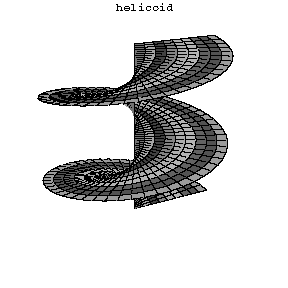Helicoid
From Encyclopedia of Mathematics
A ruled surface described by a straight line that rotates at a constant angular rate around a fixed axis, intersects the axis at a constant angle  , and at the same time becomes gradually displaced at a constant rate along this axis.
, and at the same time becomes gradually displaced at a constant rate along this axis.

Figure: h046880a
If  , the helicoid is called straight or right (cf. Fig.); if
, the helicoid is called straight or right (cf. Fig.); if  , it is called oblique. The equation of a helicoid in parametric form is
, it is called oblique. The equation of a helicoid in parametric form is
 |
Comments
Every straight helicoid is a minimal surface (it is then sometimes called minimal). See [a2], [a1]. Moreover, a ruled surface which is minimal is necessarily a part of a right helicoid.
References
| [a1] | M.P. Do Carmo, "Differential geometry of curves and surfaces" , Prentice-Hall (1975) pp. 214 |
| [a2] | M. Spivak, "A comprehensive introduction to differential geometry" , 1979 , Publish or Perish pp. 218–219 |
| [a3] | B. O'Neill, "Elementary differential geometry" , Acad. Press (1966) |
| [a4] | M. Berger, B. Gostiaux, "Differential geometry: manifolds, curves, and surfaces" , Springer (1988) (Translated from French) |
How to Cite This Entry:
Helicoid. Encyclopedia of Mathematics. URL: http://encyclopediaofmath.org/index.php?title=Helicoid&oldid=28216
Helicoid. Encyclopedia of Mathematics. URL: http://encyclopediaofmath.org/index.php?title=Helicoid&oldid=28216
This article was adapted from an original article by A.B. Ivanov (originator), which appeared in Encyclopedia of Mathematics - ISBN 1402006098. See original article